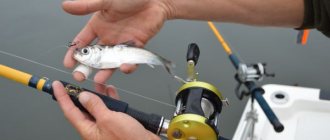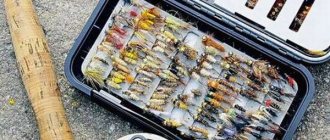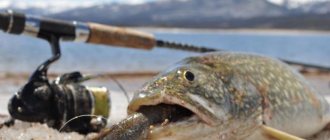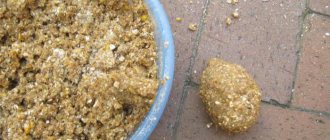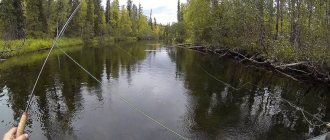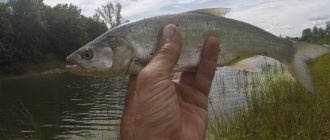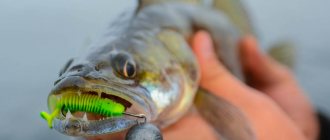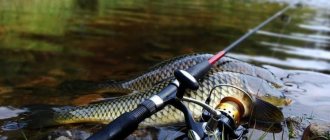Yuri 09/21/2020 611
Since the appearance of pheromone-based bait in fishing stores, there has been ongoing debate among fishermen about the importance and effectiveness of this product in fishing. Almost everyone agrees that using a regular bait mixture increases the likelihood of fishing success. But whether it should contain pheromones for fishing, opinions differ.
Let's try to understand this issue from a scientific point of view. Let’s define for ourselves a clear position with which the majority of our audience will probably agree. Let’s look at the whole question “piece by piece” and tell a respected fellow fisherman about what pheromones are, whether they have advantages and disadvantages, and whether their use in bait mixtures is appropriate.
How to lure fish to the fishing spot
Today it is difficult to surprise anyone with new bait recipes; there are a great many of them and they are all relatively effective. You can continue to use baits based on traditional recipes, but their performance is not always equally good. Even the use of flavorings used in most recipes does not radically change the overall picture. Aromatic and flavoring additives still fail, and often the fisherman is left without a catch.
After using bait with pheromones, a large increase in biting is immediately observed. The fish take the bait more confidently and swim away from a large area of water. The listed effects were the achievement of many years of research by biologists, ichthyologists and specialists in the field of synthesizing various chemicals. Pheromone-based bait shows good results in all types of fishing.
Attractants are active substances that affect the taste buds and sense of smell, attracting the attention of fish more strongly than the natural components of bait. They contain both natural components and synthetic substances.
The most advanced fishermen use substances containing fish pheromones
What do you need to know about the attractant?
When using such a product, a fragrant cloud is created around the nozzle, which arouses the interest of pike perch, pike and other predators.
With the help of attractants, you can distinguish a specific bait from the bait. Such products are sold in different forms, and they contain not only amino acids and sweeteners, but also flavorings. In most cases, these are extracts from plants, as well as substances of animal origin that are rich in hormones. Naturally, companies producing such attractants do not reveal their preparation secrets. With proper use of good flavors, the bait will become really effective when fishing for pike and other fish. Some anglers prefer to use dyes, which helps create a cloudy cloud in the water and give the bait a certain tint. However, such products are inferior to attractants, which have their own distinct taste and attractive smell.
Unlike conventional flavorings, attractants contain amino acids, the presence of which is felt by pike perch, pike and other fish. These substances affect the taste buds, awakening the predator’s appetite, due to which the fish not only approaches the bait, but also decides to bite.
Types of pheromones for fishing
Attractants can be natural, which are easy to make at home, and there are also synthetic substances. Synthesized pheromones have to be purchased exclusively in stores, while natural substances are found in almost every kitchen.
Products with a sharp, strong odor and pleasant taste (according to the “opinion” of the fish) are used as bait.
Among the most commonly used natural pheromones are recipes with:
- spices;
- vanilla;
- honey;
- garlic;
- oils of dill, anise, sunflower.
Pheromones for fish are a bite activator, which, in addition to ordinary products, can include common medical substances: Zvezdochka balm, turpentine, Corvalol. Specific recipes for attractants have also been developed with the addition of dung worm extract or animal blood extract. Dried blood with pheromones for fishing effectively attracts fish from long distances, as the smell of blood spreads over hundreds of meters. Some fishermen use kerosene; scientists have established the effectiveness of this additive.
Synthetic lures with pheromones
Bait with pheromones for fishing appeared as a result of expanding the understanding of the behavior of fish and the structure of its sensory organs. During the development, scientists from various scientific fields were involved, and according to numerous fishermen, the result is worth it.
Synthesized pheromones for fishing do not just attract fish, because this is not enough for fishing success. All effective fishing methods involve not only attracting attention, but also increasing the fish’s activity in relation to the bait.
Fish baits with pheromones simultaneously have 3 key effects:
- lure fish to the feeding area;
- increase the feeling of hunger, even well-fed fish greedily grab the bait;
- provoke fish to form schools and force them to take schooling actions.
Advanced developments can induce a feeling of hunger in fish; this effect has not been achieved before. This action became possible thanks to the discovery of a method for the synthesis of substances produced in the body of hungry individuals. Synthetic ingredients are completely consistent with their natural counterparts. Having delivered the pheromone bait to the fishing site, the victim experiences an urgent need to look for food, this leads to an attack on the bait on the hook.
Hungry individuals of most fish species tend to flock together when they feel hungry. It is easier for a fisherman to get a good catch in one place; he often manages to get 10-20 medium or 3-7 large fish from one place with constant, continuous bites.
Factors for successful use of pheromones:
Many factors can potentially influence the success of a monitoring program:
- Pheromone lures. Manufacturers replicate these chemical compounds for use in traps, but the accuracy of the replication directly affects the success of the trap. Therefore, it is important that the bait with pheromones uses high quality chemical components, and their ratio corresponds to natural ones. These considerations are further complicated by the type and quality of dispenser used. The pheromone will be absorbed by some kind of dispenser (rubber stoppers or plastic bottles). Different materials release pheromone at different rates, and low-quality materials contain contaminants that can react with the pheromone, severely affecting performance. Therefore, it is essential to use quality bait for accurate monitoring.
- Trap design. The type of trap used depends on the behavior of the insect and the location used. Here you need to proceed from your data in order to select the best option from a variety of trap designs.
- Pheromone trap color. The color of the trap can significantly affect the attractiveness of some insects. Even if the color does not matter to the intended pest, it is better to choose a color that is less attractive to beneficial insects.
- Correct placement of pheromone traps. Trap placement can have a big impact on performance. The decision to initiate a selected pest control strategy is usually made when an action (or economic) threshold is reached, i.e. a certain number of insects caught on each trap during the week. The choice of pest management strategy depends on the crop and the pest.
Preparation of pheromone-based bait
The modern market is replete with various bite activators; dozens of manufacturers are represented here. There are options for liquid and tablet forms, but their effect is completely identical, the only difference is the different methods of addition. The easiest way to get a big catch is to purchase attractants. Some fishermen consider this an unjustified expense and make pheromones for fishing with their own hands.
If you plan to make pheromones for fishing at home, it is important to correctly understand the composition of such products. Need to use:
- vegetable oils;
- flavorings, they imitate the smells of fruits or other food;
- all kinds of squeezes;
- amino acids;
- spices;
- components of animal origin, their type is chosen taking into account the type of fish that is planned to be hunted.
There is not yet enough data to determine the composition of pheromones, since consistency plays a significant role:
- in liquid form. The products have a strong odor; they are often used to treat wobblers, spinners and other silicone and foam baits. Ideally, 0.5-0.7 g of attractants are used for a wobbler weighing 10 g, the proportion almost always works;
- dry options. They are dried or pressed. Can be added to water without additional ingredients, although it is better to add it to bait.
In practice, the production of pheromone baits depends on the type of fish that you plan to catch.
Hemp seeds: excellent groundbait and bait
The following recipe is often used for carp and other carp fish:
- We prepare the corn kernels, they also act as the basis of the mixture. We choose small and not too young grains.
- Pour the corn kernels into a container, into which then pour water. We infuse the bait in water for 3-5 days.
- Place the mixture on the fire, and after boiling, cook for 1 hour. Stir the mixture while cooking the homemade attractants. Ultimately, you should get a homogeneous mixture.
- Remove the unfinished mixture from the heat and leave until cool. After reaching room temperature, add sugar and honey; carp like sweet tastes and smells.
To hunt crucian carp, it is better to use the following bait recipe with pheromones for fishing:
- We select a glass jar with a capacity of 1 liter and pour 50 g of pearl barley into it, fill the remaining space with boiling water. Wrap the jar in a blanket or warm towel to retain heat inside. We can use a thermos instead of a jar.
- We leave the product for 3-4 hours, during the specified period of time the grains swell. It is important to achieve softness of the cereal, but not to allow it to become overcooked and uniform in consistency.
- We add any flavoring to the mixture: vanillin, anise, garlic, reed roots, cocoa, dill seeds, etc.
Pheromone traps Types of traps
For monitoring, pheromone traps are used, which can be divided into two main types. The first type is pheromone glue traps, consisting of 3 main elements: a body (made of laminated cardboard or plastic), an adhesive liner coated with non-drying glue, on which the lured insects are caught, and a dispenser from which the pheromone evaporates. Adhesive inserts are replaced as they become clogged or the glue dries out. Rubber pheromone dispensers are replaced every 5-6 weeks, while foil dispensers containing pheromone and solvent can remain effective for up to 3 months. Typically the dispenser contains 0.5–2.0 mg of synthetic pheromone. Glue traps are used to monitor pests in orchards. Traps of the second type - glueless - also consist of a body and a dispenser, but do not have an adhesive liner; To catch insects, they use reservoirs (receivers) of various designs, from which insects are not able to escape. These traps can be used to catch live insects; they can also be equipped with insecticidal inserts to kill pests.
A little history The effect of insect pheromones was known to people in ancient times. These odorous substances in the honey bee (Apis mellifera) were first described by the English naturalist Charles Butler in his book “The Female Monarchy,” which was published in 1609. The French entomologist Jean-Henri Fabre in the second half of the 19th century conducted experiments with Saturnia butterflies (Saturnia pyri). He discovered that a female Saturnia, just emerging from the pupa, is capable of attracting dozens of males of its species from a distance of several kilometers. The chemical composition of insect pheromone was first determined by German biochemist and Nobel laureate Adolf Butenandt in 1959. It took him and his team 20 years of careful experimentation to isolate 6.4 mg of bombycol, the sex pheromone of the female silkworm (Bombyx mori). The term "pheromone" was proposed by the German biochemist Peter Carlson and the Swiss entomologist Martin Lüscher, also in 1959; it comes from two Greek words: “pherein” - to transfer, and “hormone” - to excite, i.e. "excitement carrier". In 1960, American scientist Martin Jacobson and his colleagues were able to determine the structure of the gypsy moth sex pheromone and then synthesized its analogue. The resulting synthetic pheromone preparation has become widely used in traps to monitor this pest in the United States. By 1984, pheromones from 670 insect species had been synthesized worldwide. In the USSR, already in 1976, American-made pheromone traps began to be used to monitor the eastern codling moth, and in 1978, the use of domestic traps began. By 1990, 26 domestically produced pheromone preparations were approved for use in the USSR. To date, scientists from different countries have identified pheromones of several thousand species of insects, many of which are pests of agriculture and forestry.
Which pheromones to use for a certain type of fish
Pheromones for biting fish have different compositions depending on the natural preferences of the prey. Some types of fish respond well to sweet aromas, while others prefer exclusively animal odors. Taste preferences are influenced by the climatic features of the place, the type of reservoir, the availability and type of food. Relatively related fish have approximately similar tastes, but the greater the differences between species, the more significant the difference in nutrition.
Different types of fish prefer certain foods and actively react to odors that are specific to them.
There are universal pheromones, they are aimed at attracting a large number of fish species, but when hunting specific prey it is better to use specialized attractants.
Narrowly targeted pheromones attract prey more effectively and rarely provoke interest in small fish, this reduces the number of unsuccessful bites.
Attractants whose smells the fish encountered in the reservoir perform best.
Additionally, the composition includes acids that awaken appetite:
- dairy;
- glycine;
- glutamine, etc.
Application of pheromones depending on the purpose
For each type of fish, suitable complementary food is used, because if food is used correctly, targets for quiet hunting react faster and more actively to the smell and gather around a person with a fishing rod. When choosing bait, the fish’s habitat, conditions and natural food are taken into account.
Each type of fish has its own food preferences. Based on such knowledge, scientists create pheromone baits for fishing that specifically affect a certain population of aquatic inhabitants.
Modern fish baits contain components that have a specific aroma that attracts a certain type of fish. Most often, such fillers contain particles of food that the fish eat.
Also, chemicals are added to the preparations that have a positive effect on aquatic inhabitants, for example, acids:
- dairy;
- glutamine;
- glycine
Substances with propylene glycol also perform their role very well as pheromone baits for fish, attracting various species of inhabitants of the aquatic world. Attractants not only excite the fish’s taste buds, but also act on the instincts. That is why it is most effective to use baits aimed at a specific type of inhabitants of lakes and rivers.
In the store you can find attractants that act on:
- Pike.
- Pike perch.
- Bream.
Nevertheless, there are also universal baits with pheromone impregnation, which are used for hunting predators or more peaceful aquatic inhabitants.
Pheromones for catching aquatic inhabitants are biological substances created artificially. Their properties are identical to natural attractants. They are necessary to get a good bite, because they attract schools of fish, cause a strong feeling of hunger, forcing them to actively move in search of food.
There is a way out of this situation if you use bait with pheromones. Soft fish bait is impregnated with odorous substances.
Source: orybalke.com
The use of pheromones in fishing
Many people are interested in fishing, and everyone pursues their own goal: a hobby, leisure time, sports, food production. Regardless of whether fishermen are motivated by amateur or sporting interest, everyone wants to get more and bigger trophies. To achieve better results in fishing, people have learned to use many additional methods. From cutting-edge gear to special complementary foods. And the most advanced fishermen use the latest substances containing pheromones for fish.
How to lure fish to the right place?
Feeding at the fishing site is a very successful and long-known method, carried out both before and during the fishing process. Now, when there are more people who want to get a good catch than the fish themselves, feeding them with familiar food products (porridge, bread) is not always effective. At a minimum, it is necessary to add flavoring or aromatic components to which cold-blooded inhabitants react.
The long-term joint work of chemists, biologists, ichthyologists and other scientists has led to the production of special substances that lure fish, which are successfully used in all types of fishing.
Traditional attractants
Various food products have always been used in fishing; they do not need to be purchased specially; most often, most of them are present in any kitchen. It is worth using products that have a specific taste and smell:
- Food products such as:
- honey;
- vanillin and similar confectionery spices;
Photo 1. Cinnamon and vanilla are the most common bait flavors.
- sunflower oil, dill, anise, hemp, etc.;
- clove decoction;
- garlic.
Photo 2. Garlic is one of the most popular attractants.
Photo 3. Corvalol has also been used in fishing for a long time.
These products have a different purpose than luring fish. Their effect has not been proven by scientists or research, but they have been used effectively in fishing for a long time. Traditional attractants are determined by the experience of our ancestors.
Traps for vegetable pests
Pheromone traps for monitoring the flight dynamics of the cabbage cutworm (Mamestra brassicae) in vegetable plantings are placed on poles 10–12 days before the expected start of butterfly flight. On each field of cabbage, tomatoes and other vegetable crops, 3 traps are placed per 5 hectares; on areas over 10 hectares - an additional 1 trap for every 5 hectares. Inspection of traps before the start of butterfly flight should be carried out daily, and then once a week; At the same time, the captured moth butterflies are counted. The beginning of the cabbage cutworm flight is considered to be the date of catching the first butterflies. Mass flight is usually characterized by a sharp increase in catches - 6–8 or more butterflies per 1 trap in 5 days. Treatments of cabbage with biological (Bikol, Lepidocid, Fitoverm) or chemical (Arrivo, Herold, Intavir, Sumi-alpha, etc.) preparations are timed to coincide with the mass hatching of cabbage cutworm caterpillars, adjusting the forecast for caterpillar counts on plantings. As a rule, it occurs 5–7 days after the mass flight or 16–20 days after its start. Similarly, monitoring of other cutworm species that damage vegetable crops can be carried out.
Pheromone-based lures
Modern scientific research in the field of fisheries began to use pheromones as bait almost two decades ago. The effectiveness of these products was proven and patented back in 2001. Their action is aimed at the natural receptors of fish.
It has long been known that these silent creatures communicate with each other by exchanging specific signals, which are sent using pheromones. Just as humans synthesize hormones, fish produce certain pheromones in different situations. Thanks to them, fish individuals gather in schools, reproduce, feed, and exist. It is worth noting that the olfactory abilities of these aquatic inhabitants are more developed than those of dogs.
Many years of studying the life activity of fish allowed scientists to artificially synthesize substances that attract their attention. But it happens that the interest of aquatic inhabitants alone is not enough. We've all had cases where fish walk around but don't bite. Thus, modern bait with pheromones is aimed at:
- to attract attention;
- stimulation of hunger;
- pack reflex.
Hunger-stimulating pheromones represent the most modern group. These artificially synthesized substances are identical to natural ones, which are produced in the body of hungry individuals. They help to increase the natural feeling of hunger in fish, prompting them to immediately search for any food. Thus, the fish does not easily swallow the bait; it actively searches for any type of food.
Groundbait with pheromones
Many commercial websites offer people who are interested in fishing to purchase so-called universal bait mixtures containing attractants. This is the name given to synthetic and natural aromatic chemicals that cause living organisms to be attracted to the source of odor. Thus, pheromones are also attractants.
According to the assurances of managers of selling sites, when using these baits, the fish almost sits on the fisherman’s hook itself. The opinions of fishermen on this matter are divided: some believe that the presence of bait with attractants when fishing increases the likelihood of success, others are inclined to believe that this is just a marketing ploy and a way of pumping out money.
Whether or not to believe the loud statements of managers is up to everyone to decide for themselves. It is difficult to draw any conclusions without testing the bait yourself under different conditions. Moreover, in the absence of verified information about scientific research conducted in this direction.
However, many manufacturers of bite activators claim that such research has been carried out, and already in 2001 the effectiveness of the chemicals was proven and patented. Pheromones synthesized in a special way in laboratory conditions can influence the behavior of fish:
- attract her to the feeding place;
- stimulate the feeling of hunger even in well-fed fish;
- excite pack reflexes in individuals.
Attractants with pheromones for different types of fish
Different populations of fish prefer certain foods and react more actively to odors that are special to them. This is due to the nature of the fish’s habitat, climatic conditions, reservoir, and natural food. The less related the fish species, the more different their tastes. Based on this, manufacturers create baits aimed at attracting certain populations.
These baits consist of components that have a specific taste and smell that are of interest to a specific type of fish. More often these are elements of food with which she is already familiar. But with the inclusion of chemicals that have an effect on fish, for example, acids:
- glycine;
- dairy;
- glutamine and the like.
Propylene glycol substances also attract the attention of fish. The action of attractants is aimed not only at the taste preferences of fish, but also at instincts. Therefore, the effectiveness of baits using pheromones that attract the attention of specific fish is much higher. Thus, attractants have been developed for catching crucian carp, pike, catfish, pike perch, carp, bream and others. There are universal attractants for predatory or peaceful fish.
Predatory fish often obtain food, relying mainly on vision. Therefore, it is interested in bait and swallows soft baits (polymer, silicone) well, but due to inedibility, it often spits them out. This is where the possibility of impregnating soft bait with an attractant containing pheromones and other attractive components comes to the rescue.
What are pheromones
Pheromones are chemical substances produced and released into the external environment by insects to communicate with other members of their species. These substances, being means of intrapopulation regulation, play an important role in communication, including ensuring the closeness of males and females during the breeding season.
The use of pheromones in insect control is environmentally friendly and widely used. These are non-toxic, biodegradable chemicals that are used to modify the behavior of specific insects and have no effect on other insects or non-target organisms. The desire to optimize protective measures and reduce the negative consequences of using insecticides necessitates improving existing methods for recording harmful insects and signaling the timing of protective measures. Synthetic analogues of insect pheromones are suitable for this purpose and can be used as one of the most economical and accurate methods for detecting and assessing the density of pest populations. Competent and effective use of synthetic pheromones is possible with knowledge of various aspects of insect pheromone communication.
Insects secrete pheromones to alert other insects to information such as insect sex, location, alarm, and grouping. Synthetic pheromones mimic chemicals produced by insects and are used, among other things, to lure certain types of insects into special traps. Pheromones used today are produced through chemical synthesis. But many experiments are being carried out that will help synthesize pheromones using plants and microorganisms, which can significantly reduce the cost of production and the price of them. Microorganisms and plants can provide platforms for sustainable and commercially viable production of insect pheromones, but there are challenges that need to be overcome before this technology is ready for market release.
Release form of pheromone baits
Bait using pheromones is widely produced by well-known manufacturers who are engaged in development and work closely with chemists, biologists, and ichthyologists. Small firms also produce bait, but their technology is more based on traditional food additives or animal blood extracts.
You can make such pheromones for fishing with your own hands. The most interesting components for fish, which are often on hand, are discussed above. All that remains is to study the information about the preferences of certain species for which the potential catch is designed. And then you just need to prepare the desired mixture.
Groundbait with pheromones is sold in various forms:
It is worth choosing the form that is most convenient for a particular fishing.
Rules for using bait with pheromones
Depending on the form of release and the concentration of the active substance, bait is used in its pure form (spray, gel) or diluted in the amount of water or feed prescribed according to the instructions. For example, the well-known attractant Ultrabyte is available in 5 ml ampoules. According to the instructions, this concentrate should be diluted in 0.5 liters. water. To avoid overspending, you can take the required amount using a medical syringe, and then dissolve it in the appropriate volume of liquid. But it is recommended to seal the ampoule or seal it with fishing plasticine to preserve the properties of the active elements.
Pheromone traps in IPM
The principal use of sex pheromones is to attract insects to traps to detect and determine temporal distribution. Males respond to sex pheromones. Therefore, bait traps are designed to accurately reproduce the ratio of chemical components and the rate of release of pheromones by females. Trap design is critical to the effective use of traps for monitoring insect populations. Traps vary in design and size depending on the behavior of the target insects. Consistent trapping protocols are necessary for population estimates, spray thresholds, and year-to-year comparisons. Trap information can be very useful in making decisions about insecticide applications or other control measures. Traps may also be set to kill males to control the population.
Examples of pheromone traps
Using Pheromone Thrip Traps Research conducted by Dr. Rose Buitenhuis' lab in Vineland shows that thrips catch rates are higher when baits are used in addition to sticky traps. These baits contain pheromones that attract thrips. Marketed as an improved monitoring tool, baits can be used to improve mass trapping. The results of this study are actively used in practice as an integrated approach to pest protection.
Catching thrips using sticky traps
Traps containing pheromones caught twice as many thrips (Graph courtesy of R. Buitenhuis). By paying attention to the color, placement and density of traps, and considering the addition of pheromones, it is possible to maximize the amount of thrips removed from the greenhouse, allowing for better control of the greenhouse situation. Some manufacturers have included pheromones against pests in their roll traps (at the moment the list of such traps is not very large), combining this with a selected color spectrum for a specific pest. So, using thrips as an example, using pheromones on blue traps, which is the most attractive for this pest, tests showed that thrips catching increased by 30-100%.
Is the use of pheromones in fish bait justified?
After reading fishing forums, I came across a very interesting topic in modern fishing - the use of pheromone-based bait. Reviews about this technology are positive, so let's figure out what the essence is and why fishermen are so interested in this topic?
Scientific experiments back in 2001 revealed that pheromones in bait are a very effective remedy.
❗ The action of pheromones, both purchased and personally prepared, qualitatively affects the receptors of residents of reservoirs.
The effectiveness of pheromones for fishing
Let me remind you that fish, like people, can communicate only through special signals. They also recognize each other using the pheromone they secrete. This is how they get into flocks, feed together and reproduce. I am ready to conclude that without pheromones fish would not exist.
❗ Pheromones added to bait mixtures for fish are synthetic if you buy the product in a store.
They are identical to the natural pheromone that fish secrete. However, after consulting with other fishermen, we came to the conclusion that fish are not always interested in such a product.
Two directions of use
The advantages of synthetic pheromones used in microdoses are high species specificity and attractiveness. They are absolutely harmless to humans and the environment and act only on the target species of pest.
There are two main areas of practical use of synthetic pheromones against harmful insects: 1) Monitoring. Pheromones make it possible to detect the onset of flight of pests, obtain data on their numbers, or determine the range of quarantine pests. 2) Direct pest control. By saturating the air with a synthetic pheromone, you can prevent males from finding females; It is possible to attract insects using a pheromone and trap or destroy them before they can detect the natural source of the pheromone. In both cases, the reproduction of pests is disrupted.
Pheromone monitoring is the most economical and accurate method for recording many types of pests. Thus, the use of pheromone traps to determine the number of grape budworm (Lobesia botrana) in vineyards is 15–20 times more effective than other counting methods.
Groundbait with pheromones for various types of fish
In a reservoir you can find a large number of different fish populations, each of which has its own taste preferences.
Fish react more actively to special odors, which is associated with the nature of the fish, climate, water, and natural food. Actually, for each type of fish that you are going to catch, you need to select your favorite ingredients.
Therefore, before fishing, I carefully prepare bait mixtures for different fish, according to their taste preferences, to which I then add pheromones (both purchased and personally prepared).
The pheromones that I found in a specialty store consist of ingredients that the fish species is already familiar with. These are the same natural products, just with added chemicals. In this case, chemistry has a positive effect on fish.
The action of the attractant is also aimed at attracting fish, but it is slightly different from pheromones. The action of the attractant mixed with pheromones affects not only the tastes of the fish, but also the instinct. Therefore, a bait mixture with both an attractant and a pheromone increases your chances of catching a big fish.
